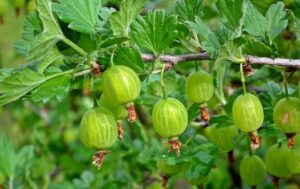Gooseberry Sawfly Control Methods

The gooseberry plant or bush is “native to many parts of Europe and western Asia, this berry plant belongs to the family Euphorbiaceae and is commonly known as Amla, Indian gooseberry, and emblic myrobalans”. The gooseberry bush which is a citrus plant can be found growing naturally in rocky alpine thickets and the rocky woods in the lower country from France eastward, well into the Himalayas and peninsular India.
Growing gooseberry in the home garden can become a challenge where sawfly (gooseberry sawfly) is present, if you’re growing this bush in your garden and have a sawfly issue look no further you have come to the right place to bring this garden pest under control.
Gooseberry Sawfly Biology
The gooseberry sawfly can have 3 generations a year, the female sawfly lays her eggs on the leaves undersides low down in the center of the bush. This hides the larvae of the gooseberry sawfly, sawfly larvae, and its damage is only noticed when they have eaten their way upwards and outwards as they consume the entire leaves.
The larvae are active from late April to June, July, August, and September, when the larvae are fully fed they drop to the soil surface followed by burrowing into the soil. Once this is accomplished they spin silk cocoons and pupate.
Adult Gooseberry Sawfly Identification
The adult gooseberry sawfly is yellow with black markings and blackheads.
Identifying the Gooseberry Sawfly Larvae
The gooseberry sawfly larvae are pale green in color, black-spotted with a black head.
Signs of Gooseberry Sawfly
Signs of gooseberry larvae damage are the leaves being consumed which will lead to complete leaf defoliation causing server gooseberry bush damage that will encourage loss of fruit set.
How to Control Gooseberry Sawfly
The good news is that even though sawflies cause damage these control methods can bring sawfly elimination.
Organic Control
If the infestation of gooseberry sawfly numbers is too great to remove by hand picking then another alternative is the use of organic pesticides. Neem oil makes a great choice and will help to bring control, buying a Pyrethrum product that can be diluted in water will also help to control sawfly. It is always best to read the manufacturer’s label however before applying which will give the best results.
Companion Planting
Companion planting involves installing plants among your garden plants that will control insects pests, some plants to install to encourage predatory insects to your garden are beans, onions, chives, coneflowers, yarrow, marigolds, sunflowers, etc… installing or placing a few flat stones or boards serves as a resting place for ground beetles during the day hours. If you plan to search for ground beetles then look for rotten logs or wood piles that they use as their harbourage. Collect ground beetles and release them in your garden.
Plants that attract birds are coneflowers, sunflowers, black-eyed-Susan, zinnia, salvia, aster, milkweed, cardinal flowers, elderberry, holly, etc…it will also help to include a bird bath especially one with moving water that will get their attention faster. This added feature will not only encourage birds into your garden but cause them to stay a while as they bathe and take a drink of water.
Biological Control
Biological control involves natural means which include the use of birds and ground beetles in your garden, to encourage birds and ground beetles install some of the listed plants under companion planting.
Another method of controlling the gooseberry sawfly is to use nematodes, nematodes are microscopic roundworms that are sprayed directly on the infected plant or larvae. Once the larvae ingest the nematode, bacteria are produced killing the gooseberry sawfly larvae, the nematodes in turn feeds on the liquified contents of the sawfly larvae. This method of the gooseberry sawfly however is considered to be expensive along with having a short shelf life once opened.
Mechanical Control
Mechanical control of the gooseberry sawfly involves removing the caterpillars or larvae which may be a tedious job, this involves handpicking and throwing them into a container of soapy water that will eliminate them.
The final word on gooseberry sawfly control
Winning the war on the gooseberry sawfly is that simple by following these effective methods, all it takes is some know-how. You have come to the right place for success. The gooseberry sawfly is not only a nuisance but destructive, but the destruction can be short-lived with this guide so if these uninvited guest is making a meal out of your gooseberry bush then follow as directed for good success.
About the author
Norman loves being in the garden, both at home and for his job....
he is 'Natures Little helper' being outdoors, growing his vegetables and flowers from an early age.
Now having spent over 22 years in the profession he want to give some of his knowledge to others...
his vast array of hints and tips you will find scattered over this site will help you no end growing plants in your garden.
